Foreign Insulators
by Marilyn Albers
Reprinted from "Crown Jewels of the Wire", September 1989, page 12
ON THE FOREIGN INSULATOR SCENE AT THE NATIONAL
It's September and we're all still basking in the glow of the 20th NIA
National Show weekend in Allentown, Pennsylvania, July 14-16. What a super show!
There were more dealers, more displays, more collectors and curiosity seekers
roaming the aisles, more good insulators and more enthusiasm than at any
National Show since Berea, Ohio, in 1976. The three show hosts of this big event
are truly to be congratulated for a job well done. Stand up, FRANK EDGAR, DAVE
WIECEK and DOUG WILLIAMS!!
My husband Bill and I flew up from Houston the
Wednesday before the show so we could visit with Dick and Inge Clark of Somers,
New York. We thoroughly enjoyed the time spent with them at their home. This
delightful couple, both educators by profession, promised each other when they
married that they would take time to travel every summer. This they have done
during their 45 years together and, needless to say, they have acquired quite an
impressive collection of American and foreign insulators. Dick shared an amusing
story with Crown Jewels of The Wire readers in the May, 1989, issue entitled
"Insulators Undo the 'Ugly American' Image." You remember reading how
he managed to free two porcelain insulators from the side of a railroad station
in a Czechoslovakian village. These beauties were mounted on display pegs in
Dick's insulator room, and since they were identical, we were able to work out a
happy trade so that I might come home with one of them. I'm proud to show you a
photo of Dick and Inge as well as one of these special insulators, which will
have a U-number assignment by and by. The crown is marked simply RH29.

Dick and Inge Clark
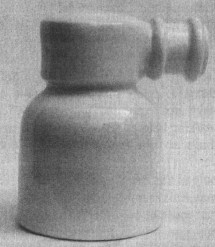
Czechoslovakian insulator belonging to Dick Clark
On to the National! Bill and I occupied sales tables close to the entrance
of the Exhibit Hall and were proud to be able to display some really unique
glass and porcelain insulators that Don Fiene (Knoxville, Tennessee) brought
back from his recent trip to the USSR. Unfortunately, most of them were not for
sale, but many collectors stopped by to admire them and ask questions. An
upcoming issue of Crown Jewels of the Wire will have photos of these pieces
along with Don's account of his latest adventure in the Soviet Union. Watch for
it!
Several other desirable foreign pieces appeared on sales tables throughout
the hall. It would be impossible to describe them all -- you shudda been there!
Bill Rosato (Elizabethtown, Pennsylvania) had the impressive porcelain piece you
see pictured in the next column. This twist lock insulator has an inner
petticoat, measures 4-1/4" across the base and is 5-1/2" tall. There
are no identifying marks on it, but Bill said he found it in Norway. Isn't it a
beauty? This one also awaits a U-number.
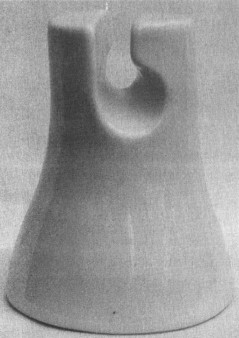
Dave Kingston (Fort Lauderdale,
Florida) brought several Greek porcelain insulators to show Carol McDougald and
me and after he let on that they were for sale (he had duplicates), they were
quickly divided between two new homes -- Houston, Texas, and St. Charles,
Illinois. But let me show you two that he would not part with since he has no
others exactly like them. I managed to borrow them for a shadow profile and some
measurements, however! Here again, these represent a new style, so it looks like
there will be several U-numbers coming from Jack Tod's oven. It is uncertain
what the TTT marking stands for in the photo and Dave had no information on it,
but I'd be willing to bet that two of the T's are for "Telephone" and
"Telegraph" and the other may be the first letter of the town where it was used.


We do know that O.T.E. is for Organization of Telephones of
Ellas (the modern
word for Greece.) Incused above these blue ink markings on both insulators is a
curious logo with the letters EXME in a circle. This is probably the manufacturer,
but at this time it is unattributed. Readers have a look at it. Can you help?

The
following pictures show two views of one of Dave's Greek insulators that is now
in my collection and I really like this one! This is a 'dry-spot" insulator
and has already been classified as U-1942 with Rosenthal of SeIb, Bavaria, as
the manufacturer, but we have not seen one with the O.T.E. marking before. Also,
instead of Rosenthal's ebonite screw cap, this Greek version has a metal lid
with two inner bumps that serve as a twist lock. The material resembles that of
a fruit jar lid. As you can see, the marking on the opposite side of the skirt
is CV in a circle, the trademark of Kloster Veilsdorf Porcelain Factory located
in the city of that name in Thuringia, East Germany. So, obviously, this
insulator was made for Greece, but not in Greece. This seems to be true of several
styles used in that country. I've seen several marked O.T.E. but with
accompanying trademarks of manufacturers from other countries, such as NGK (Japan), Hermsdorf
(East Germany), etc. It's possible
that Greece imports all her insulators.
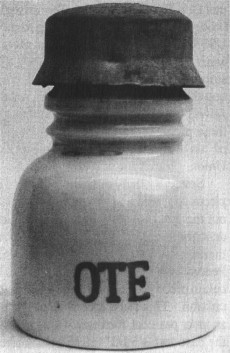
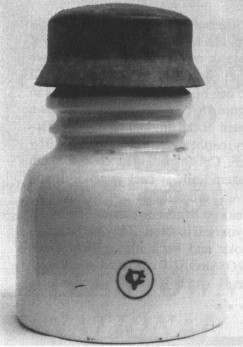
My husband said that of all the things
he saw at the show, the one thing he really wanted was a cap just like Dave
Kingston's hat. Maybe he got his wish after all. Do you see any resemblance
between Dave's cap and the one on the insulator??

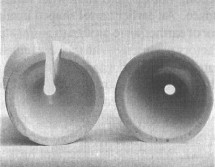

Paul Plunkett (Boonton, New Jersey) had the slotted double cone insulator you
see on the left in the above photos. The two views of these porcelain insulators
are shown to emphasize the difference. These are really quite old and they are
British. Neither one is marked, but the Buller Jobson & Co. catalog dating
somewhere between 1890 and 1895 shows that this company in Staffordshire,
England, did produce a slotted double cone insulator.
According to W. Keith Neal
(Guernsey, Channel Island) the author of SEARCHING FOR RAILWAY TELEGRAPH
INSULATORS, these two styles were used many years ago on telegraph lines running
through the damp railway tunnels of England. By their very design, they hugged
the walls of the tunnels and did not pose a hazard by projecting out into the
somewhat limited space. An earlier barrel shaped insulator of earthen ware
proved to he unsatisfactory when used with the bare uninsulated wire, which was
in common use at that time, so a Mr. C.V. Walker designed a double cone
insulator which had only one small point of contact with the wire. This one
worked a lot better. When one of these got broken, the slotted insulator was
used as a replacement. It could be put into place without having to cut the
wire. Keith says that these double cone insulators were in use by the thousands
during the 1850's but today they are extremely rare. I feel very fortunate to
have two of these in my collection! If you have Keith's book, turn to page 34
and you'll see one of the slotted double cones in Figure 18. On the opposite
page is a sketch of the original (and unsatisfactory) earthenware insulator
invented by W.F. Cooke and used on the South Eastern Railway back in 1845. If
you haven't ordered either of Keith Neal's books on British insulators, you owe
it to yourself to do so. They are beautiful books and very informative.
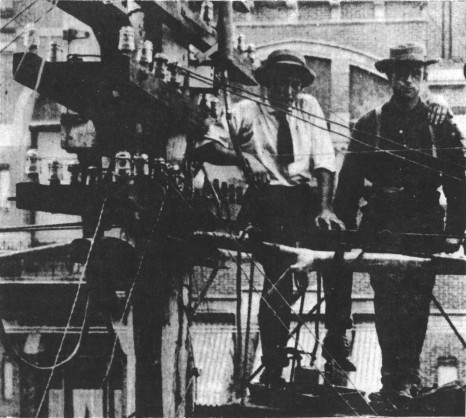
The lead-sheathed cable these linemen are installing, above,
circa 1900, would
reduce and virtually eliminate the use of open wire for aerial telephone lines.
|
